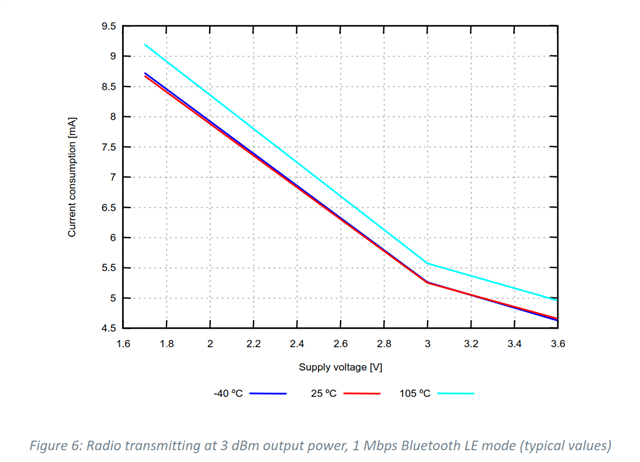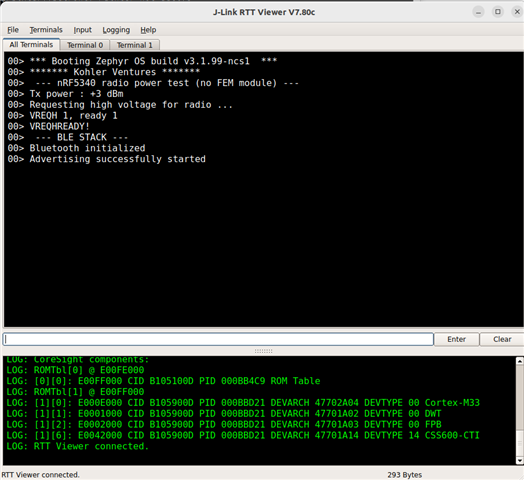I am trying to achieve +3dBm Tx power using VREQCTRL on the network core. I am currently executing the hex on normal voltage mode. I am unable to distinguish the power levels between 0 dBm and +3 dBm hexes using RSSI viewer on nRF connect app (iOS) (values at specific distances are more or less identical).
I have the following questions:
Power supply questions:
- Is a normal voltage mode, capped at 1.8V supply voltage (VDD) sufficient?
- Does VREGRADIO powering the network core internally does a DC/DC voltage boost on VREQH request.
- I also found a graph (attached) suggested 1.8V supply is sufficient for +3 dBm. Please confirm correctness.
Testing questions:
- The RSSI viewer (on nRF Connect App using an iPhone) shows -12 to -16 dBm for both 0 and +3 dBm firmwares which is the cause of contention.
- Is this a correct observation?
- How accurate are the RSSI viewers?
- Does the hardware running (in this case iPhone) makes a difference?
- Does the environment (we didn't test in a special chamber) make a difference?
- Will a spectrum analyzer help with this issue or will it have the same observations?
Thanks !
Attached:
- Source code
- RTT observation
- Graph for +3 dBm
#include <stdbool.h> #include <stdlib.h> #include <string.h> #include <zephyr/sys/printk.h> #include <zephyr/sys/byteorder.h> #include <zephyr/init.h> #include <zephyr/types.h> #include <hal/nrf_power.h> // Create test firmware for BLE or Radio stack. #define BLE_STACK true // Create firmwares for 0 dBM or 3 dBm. #define THREE_DBM false #if BLE_STACK // Add BLE stack related headers here. #include <zephyr/bluetooth/bluetooth.h> #include <zephyr/bluetooth/hci.h> #include <zephyr/bluetooth/hci_vs.h> #include <zephyr/bluetooth/conn.h> #include <zephyr/bluetooth/uuid.h> #include <zephyr/bluetooth/gatt.h> #include <zephyr/settings/settings.h> #else #include <zephyr/drivers/clock_control.h> #include <zephyr/drivers/clock_control/nrf_clock_control.h> #include "radio_test.h" #endif // Device Name. #if THREE_DBM #define DEVICE_NAME "pos3dBm_BLE_radio_test" #else #define DEVICE_NAME "0dBm_BLE_radio_test" #endif #define DEVICE_NAME_LEN (sizeof(DEVICE_NAME) - 1) #if BLE_STACK static const struct bt_data ad[] = { BT_DATA_BYTES(BT_DATA_FLAGS, (BT_LE_AD_GENERAL | BT_LE_AD_NO_BREDR)), BT_DATA(BT_DATA_NAME_COMPLETE, DEVICE_NAME, DEVICE_NAME_LEN), }; static const struct bt_data sd[] = { BT_DATA(BT_DATA_NAME_COMPLETE, DEVICE_NAME, DEVICE_NAME_LEN), }; static void connected(struct bt_conn *conn, uint8_t err) { if (err) { printk("Connection failed (err %u)\n", err); return; } printk("Connected\n"); } static void disconnected(struct bt_conn *conn, uint8_t reason) { printk("Disconnected (reason %u)\n", reason); } BT_CONN_CB_DEFINE(conn_callbacks) = { .connected = connected, .disconnected = disconnected, }; #else static void clock_init(void) { int err; int res; struct onoff_manager *clk_mgr; struct onoff_client clk_cli; clk_mgr = z_nrf_clock_control_get_onoff(CLOCK_CONTROL_NRF_SUBSYS_HF); if (!clk_mgr) { printk("Unable to get the Clock manager\n"); return; } sys_notify_init_spinwait(&clk_cli.notify); err = onoff_request(clk_mgr, &clk_cli); if (err < 0) { printk("Clock request failed: %d\n", err); return; } do { err = sys_notify_fetch_result(&clk_cli.notify, &res); if (!err && res) { printk("Clock could not be started: %d\n", res); return; } } while (err); printk("Clock has started\n"); } static void tx_modulated_carrier_end(void) { printk("The modulated TX packet transmission complete.\n"); } #endif /* RADIO POWER ENHANCEMENT. Voltage Control to achieve power beyond 0 dBm. Read more in README.md file. https://infocenter.nordicsemi.com/index.jsp?topic=%2Fps_nrf5340%2Fchapters%2Fvreqctrl%2Fdoc%2Fvreqctrl.html&anchor=frontpage */ #if THREE_DBM void radio_power_enhance(void) { printk("Requesting high voltage for radio ...\r\n"); NRF_VREQCTRL->VREGRADIO.VREQH = 1; while (!NRF_VREQCTRL->VREGRADIO.VREQHREADY) ; printk("VREQH %d, ready %d\n", NRF_VREQCTRL->VREGRADIO.VREQH, NRF_VREQCTRL->VREGRADIO.VREQHREADY); printk("VREQHREADY!\r\n"); } #endif // --- MAIN FUNCTION --- void main(void) { printk("******* Kohler Ventures *******\r\n"); printk(" --- nRF5340 radio power test (no FEM module) ---\r\n"); printk("Tx power : "); #if THREE_DBM printk("+3 dBm\r\n"); radio_power_enhance(); #else printk("0 dBm\r\n"); #endif #if BLE_STACK /* BLE STACK * Initialize and Enable BLE for connection */ printk(" --- BLE STACK ---\r\n"); int err; err = bt_enable(NULL); if (err) { printk("[ERROR] Bluetooth init failed (err %d)\n", err); return; } printk("Bluetooth initialized\n"); err = bt_le_adv_start(BT_LE_ADV_CONN, ad, ARRAY_SIZE(ad), sd, ARRAY_SIZE(sd)); if (err) { printk("[ERROR] Advertising failed to start (err %d)\n", err); return; } printk("Advertising successfully started\n"); while (1) { k_sleep(K_SECONDS(1)); } #else /* RADIO TEST * Continuous BLE packet transmission on the Tx. */ printk(" --- RADIO TEST STACK ---\r\n"); clock_init(); /* Radio parameter configuration. */ struct radio_param_config { enum transmit_pattern tx_pattern; nrf_radio_mode_t mode; uint8_t txpower; uint8_t channel_start; uint8_t channel_end; uint32_t delay_ms; uint32_t duty_cycle; #if CONFIG_FEM /* Front-end module (FEM) configuration. */ struct radio_test_fem fem; #endif /* CONFIG_FEM */ }; // Radio Config Parameters. struct radio_param_config config = { .tx_pattern = TRANSMIT_PATTERN_11110000, .mode = NRF_RADIO_MODE_BLE_2MBIT, .txpower = RADIO_TXPOWER_TXPOWER_0dBm, .channel_start = 40, .channel_end = 60, .delay_ms = 50, .duty_cycle = 50, #if CONFIG_FEM .fem.gain = FEM_USE_DEFAULT_GAIN #endif /* CONFIG_FEM */ }; // Initialize Radio struct radio_test_config test_config; if (radio_test_init(&test_config) == 0) printk("Radio Initialized.\r\n"); else printk("[ERROR] Radio Initialization.\r\n"); // Set Test Configs. memset(&test_config, 0, sizeof(test_config)); test_config.type = MODULATED_TX; test_config.mode = config.mode; test_config.params.modulated_tx.channel = config.channel_start; test_config.params.modulated_tx.txpower = config.txpower; test_config.params.modulated_tx.pattern = config.tx_pattern; test_config.params.modulated_tx.packets_num = 0; test_config.params.modulated_tx.cb = tx_modulated_carrier_end; // Start Radio. radio_test_start(&test_config); printk("Radio Transmission Started. \r\n"); #endif }



